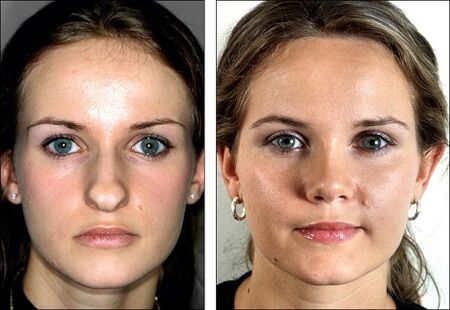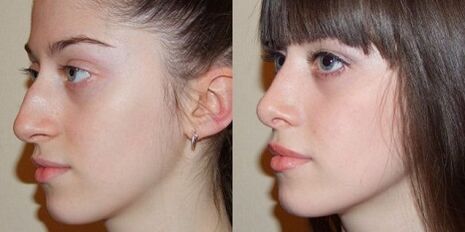The nose is an integral and important part of the face, significantly affecting our beauty and aesthetic appearance. In this article, we will look at how you can correct small and large nose imperfections with rhinoplasty.

What is rhinoplasty?
Rhinoplasty has been used in plastic surgery since the late 19th century and is a well-studied method of nasal correction. First of all, it has a cosmetic effect: it levels both congenital defects in the shape of the nose, nostrils or nasal septum, as well as those acquired as a result of trauma. And second, it has a therapeutic effect, since the crooked shape of the nose often causes major respiratory and respiratory problems.
Despite its knowledge and popularity, the operative technique is quite complicated and requires a responsible approach not only from the doctor, but also from the patient. First of all, before the procedure, it is necessary to make a detailed consultation with the doctor and all medical examinations that he prescribes. Even computed tomography, if necessary. Is important! Since in the presence of significant contraindications for operations of this type, you can get irreversible side effects for your health. A few weeks before the operation, it is necessary to exclude the use of drugs, not to smoke and not to drink alcoholic beverages.
Rhinoplasty of the nose: before and after photos

The success of the operation depends directly on the professionalism and experience of the doctor. The shape of the nose, as well as the surgical intervention in the process of its modification, are not only of great aesthetic importance, but also have a significant influence from the point of view of medicine. The various parts of the nose are closely linked to the entire respiratory system as a whole.
Therefore, this procedure requires a complete preliminary study of the nose itself and the facial structures associated with it. And any manipulations by the doctor must be clear and verified so as not to cause undesirable consequences to the patient's health. And as a result, avoid repeated surgery. Therefore, when choosing a clinic, you should not put the price of the procedure itself on the front line. Pay special attention to the doctor's qualifications and assessments.
The moment of dissatisfaction with the appearance after the operation is practically excluded. Today, each clinic has the capability of computational modeling and selection of the nose shape that suits you. You can see for yourself how you will handle the procedure and make your own adjustments.
Important tip:before making a final decision, consult your doctor. Your unsatisfactory appearance may not be affected by the shape of your nose, but completely different parts of your face are subject to correction or correction. If there are no visible defects and damages, there is even the possibility that dissatisfaction with oneself may have a purely psychological aspect. In both cases, the visible result of the procedure will be quite negative. Therefore, approach the issue responsibly.

At what age can nose rhinoplasty be performed?
Nose correction procedures are not recommended until the age of 18, or rather, before the age of 20. This is due to the fact that before that age the process of formation of the nasal cartilage occurs. And at 20 they are fully trained. It is also not recommended to perform the procedure on patients over 40 years old. At this age, the tissue healing process is much slower and the operation more complicated. Correction of the nose is contraindicated in patients with diabetes mellitus, all types of oncology, cardiovascular diseases, as well as people with poor blood clotting.
Types of nose rhinoplasty
The rhinoplasty procedure is open and closed, depending on what needs to be corrected. In closed rhinoplasty, incisions are made inside the nose and no scars are left on the skin's surface. The open type is used in cases where it is impossible to carry out the entire workload agreed in the operation plan. The scars that form practically disappear after 1-2 months.

Recovery period after surgery
Rhinoplasty, like any operation, has its own recovery period. It is short-lived, but has unpleasant consequences. In the first days, mild pain in the nose is possible. You will also have to breathe through your mouth because of the special plugs, which are removed. In addition, slight bleeding can occur for 2-3 days. But this is normal and you should not be afraid.
After the operation, a special plaster is applied to the patient, which has a fixative and protective function. After about a week, this plaster is removed and the stitches are removed. The puffiness under the eyes will go away in about 2 to 3 weeks. Well, you can evaluate the final result of the surgeon's work not earlier than 6 months.
And finally, a few months after the rhinoplasty, you have to be very careful, do not play sports or any physical activity and get plenty of rest. It is also not recommended to wear glasses.




















